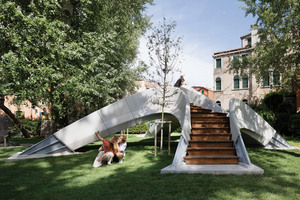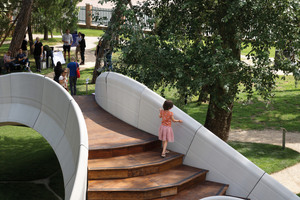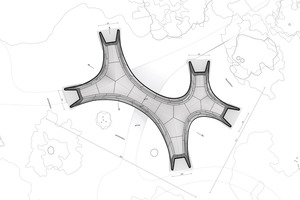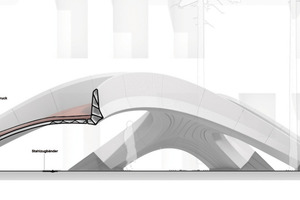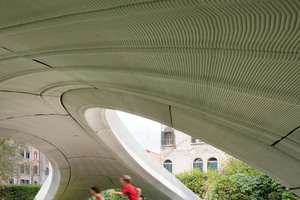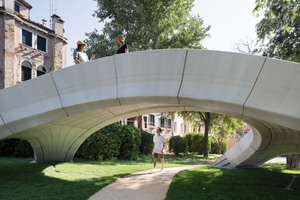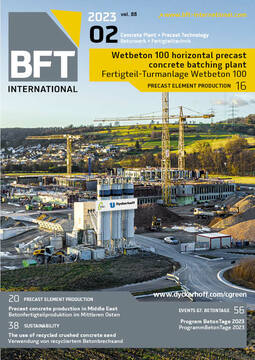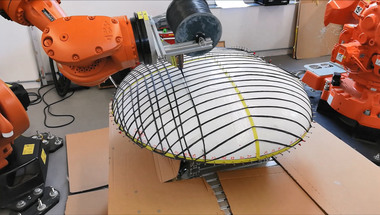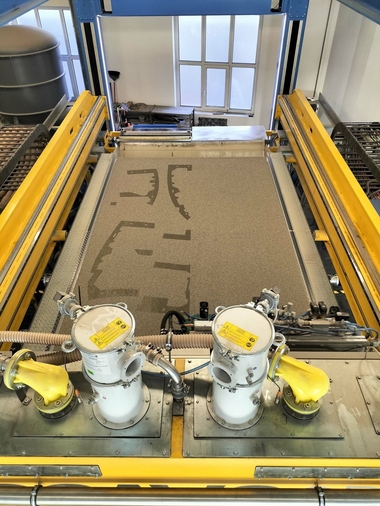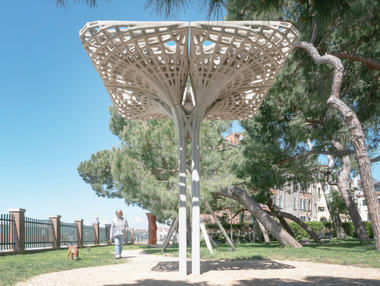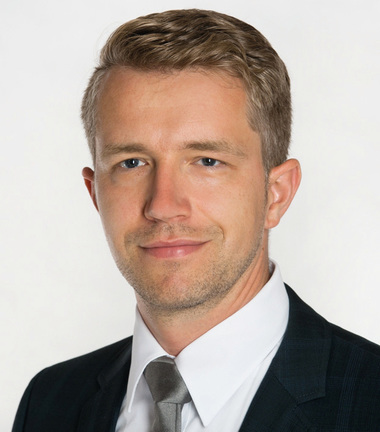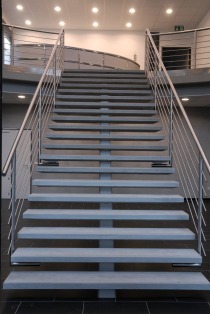Reincarnation of a structure:
„Striatus“ staircase sculpture
The „Striatus“ temporary staircase sculpture installed on last year‘s Biennale in Venice was a solid structure produced in a concrete 3D printing procedure with reduced material and could even be disassembled. In the near future, it will be rebuilt in an improved, permanent version in France. The complete article (in German language only) can be read in the „Beton Bauteile Jahrbuch 2023“ yearbook, which is available at the Profil bookstore of Bauverlag.
In Giardino della Marinaressa, an outdoor area situated south of the venue of the Venice Architecture Biennale, the staircase sculpture measuring 16 x 12 m was an extensive eye-catcher. The expressively flowing shapes unmistakably indicate the signature of its creative origin – namely the world-famous London-based Zaha Hadid Architects (ZHA) office, whose unforgotten founder of the same name passed away already six years ago.
The creators, Dr. Shajay Bhooshan of ZHA and Prof. Philippe Block of ETH Zurich, had christened the work „Striatus“. With the name, they wanted to refer to the structural logic of the manufacturing process, a 3D printing procedure consisting of countless thin concrete layers arranged mostly in parallel to each other. The building structure, however, intended to be much more than just a decorative work of art. As soon as you stepped under the overall 3.5 m high structure, a construction method made of printed concrete became visible. In fact, there were not only a few buildings realized in this construction method, in particular in 2021: We have in mind, among others, the White Tower project in the village of Mulegns in the Grisons or the residential building in the German town of Beckum (presented in the „BetonBauteile Jahrbuch 2022“ yearbook). The fact that it is a solid structure without any reinforcement, at least above ground, seems to be an advantage in view of the concrete printing process, but is not very spectacular.
53 concrete blocks
However, it becomes revolutionary with the knowledge of the logic that was applied when printing and depositing the individual printed levels. Because the total of 53 concrete blocks were not made of a structure of shotcrete layers placed horizontally on top of each other at all.
In principle, they were rather applied with the aid of a six-axis robotic arm perpendicular to the direction of the compressive forces finally acting on the structure. This reduced the concrete consumption to only 30 % of the regular demand which would be needed for the concrete structure in conventional construction. The application of concrete in specific angles and its perpendicular alignment to the occurring compressive forces leads to the fact that these layers with a thickness of 4 - 14 mm stabilize each other. The preceding, basic understanding is that in conventional concrete structures a linear geometry absorbs the curved course of a load, however, creating cavities that are inefficient in terms of static.
Suspended model
The static setup of „Striatus“ is designed so that in the entire visible structure only compressive forces occur, which are transferred into the three footings of the bridgehead, while acting diagonally outwards. Only these footing points are braced against each other in the ground with tension cables so that they cannot drift apart because of the weight forces. In fact, the quantity of steel installed here only amounted to 10 % of the reinforcing steel required in comparable conventional construction. The underlying static knowledge is the so-called suspended model, working according to the principle of inverting compressive and tensile forces: A stone arch and a rope exhibit an identical force curve – however, in the opposite direction of force. Thus, the rope model can be used in order to determine the geometry of an arch. The mass loads acting on the arch from above such as tower superstructures are replaced in the model by additional weights hanging from them.
Precisely assembled
Proven techniques were also used when it came to assembly: Similar to the railway viaducts at the end of the 19th century, a wooden falsework was erected. Then, the precast concrete elements printed by a computer were deposited on the same, stabilizing to a self-supporting system only after inserting the central keystone and lowering of the falsework. The optimized printing technique – as already mentioned – resulted in improved static properties, which in turn allowed the use of a recycled concrete as „printing ink“. The concrete ink especially developed for this project by the cement producer Holcim causes particularly low carbon emissions in comparison to „normal“ concrete, however, also has a lower modulus of elasticity than the normal one. The use of recycled building materials also resulted in a not insignificant weight reduction because all 53 concrete blocks only had a weight between 200 and 800 kg. Consequently, the construction of the staircase sculpture weighing 24.5 tons could be carried out as a small construction site. Just five workers were required here as well as a spider crane, needing only 35 days including the preparatory civil engineering works.
Recycling and future
The „Striatus“ staircase sculpture met with great approval at the Biennale and led to a considerable increase in visitors in Giardino della Marinaressa – a garden of probably 40 x 30 m that is separated by a breast-high fence from the large waterside promenade along the Canale Grande. Although people in Venice could also have imagined a perpetuation of the Striatus, it was very important for Prof. Block to maintain the temporary character of this object. For him, the impermanence associated with a careful recycling of its building materials is an essential part of the overall concept of this work of art.
Preservation through recycling
Thus, the staircase sculpture was disassembled at the end of the big art show and afterwards the 53 concrete components were first ground into small pieces. The reason for this is that the bridge will just not be erected as a temporary structure next time, but then permanently. In fact, specific agreements and corresponding planning have already been made. Where and in which context exactly, however, is still top secret. Only this much is revealed: It will be in France and even still this calendar year. Though, some improvements are intended to be carried out on this structural reincarnation. As a vivid example, Prof. Block uses the tread, which will also become an integral part of the monolithic structure, in the future. In Venice, this still consisted of an inserted wooden construction.

